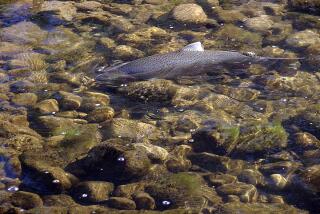Changing Tactics
- Share via
As an experienced Grand Canyon river runner, I found that Ray Ring’s article, “The Truth (Sort of) About Rafting the Colorado,” June 3, contained an abundance of disinformation ineptly disguised as ironic humor. Most of his “tips” could be written off as the complaints of someone whose advance expectations concerning a Grand Canyon river trip were unfulfilled.
Ring shows both his environmental ignorance and political naivete when he suggests to passengers to have their friends “switch on the river” by using as much electricity as possible. The use of “peaking power,” in which the Colorado River’s flows through Glen Canyon Dam often fluctuate as much as 30,000 cubic feet per second within a 24-hour period, has been shown by the recent Glen Canyon environmental studies to be damaging to the riparian habitat.
As a result of a very active letter-writing campaign by those interested in preserving the beaches, wildlife and river-running opportunities within the canyon (including thousands of letters written by river passengers such as Ring), the Secretary of the Interior has ordered that the Bureau of Reclamation begin studies for an Environmental Impact Statement concerning the use of Glen Canyon Dam as a peak-load facility.
These studies will take several years. In the interim, California Assemblyman George Miller (D-Martinez) has introduced legislation that will develop and implement emergency interim operating criteria for Glen Canyon Dam. Those interested in preserving the riparian habitat of the Colorado River through the Grand Canyon should write their senators and congressmen and ask them to support Miller’s legislation (HR4498).
I recognize that Ring’s article was written tongue-in-cheek. But for the millions of us who truly appreciate the unique splendor of the Grand Canyon, and the effort to save its beaches, riparian habitat and wildlife, it is a matter of deep concern.
HOLLY MITCHEM
Ojai
More to Read
Sign up for Essential California
The most important California stories and recommendations in your inbox every morning.
You may occasionally receive promotional content from the Los Angeles Times.










